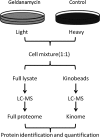Systematic identification of the HSP90 candidate regulated proteome
- PMID: 22337586
- PMCID: PMC3433914
- DOI: 10.1074/mcp.M111.016675
Systematic identification of the HSP90 candidate regulated proteome
Abstract
HSP90 is a central player in the folding and maturation of many proteins. More than two hundred HSP90 clients have been identified by classical biochemical techniques including important signaling proteins with high relevance to human cancer pathways. HSP90 inhibition has thus become an attractive therapeutic concept and multiple molecules are currently in clinical trials. It is therefore of fundamental biological and medical importance to identify, ideally, all HSP90 clients and HSP90 regulated proteins. To this end, we have taken a global and a chemical proteomic approach in geldanamycin treated cancer cell lines using stable isotope labeling with amino acids in cell culture and quantitative mass spectrometry. We identified >6200 proteins in four different human cell lines and ~1600 proteins showed significant regulation upon drug treatment. Gene ontology and pathway/network analysis revealed common and cell-type specific regulatory effects with strong connections to unfolded protein binding and protein kinase activity. Of the 288 identified protein kinases, 98 were geldanamycin treatment including >50 kinases not formerly known to be regulated by HSP90. Protein turn-over measurements using pulsed stable isotope labeling with amino acids in cell culture showed that protein down-regulation by HSP90 inhibition correlates with protein half-life in many cases. Protein kinases show significantly shorter half lives than other proteins highlighting both challenges and opportunities for HSP90 inhibition in cancer therapy. The proteomic responses of the HSP90 drugs geldanamycin and PU-H71 were highly similar suggesting that both drugs work by similar molecular mechanisms. Using HSP90 immunoprecipitation, we validated several kinases (AXL, DDR1, TRIO) and other signaling proteins (BIRC6, ISG15, FLII), as novel clients of HSP90. Taken together, our study broadly defines the cellular proteome response to HSP90 inhibition and provides a rich resource for further investigation relevant for the treatment of cancer.
Figures







Similar articles
-
Posttranslational modification and conformational state of heat shock protein 90 differentially affect binding of chemically diverse small molecule inhibitors.Oncotarget. 2013 Jul;4(7):1065-74. doi: 10.18632/oncotarget.1099. Oncotarget. 2013. PMID: 23867252 Free PMC article.
-
Prospective identification of resistance mechanisms to HSP90 inhibition in KRAS mutant cancer cells.Oncotarget. 2017 Jan 31;8(5):7678-7690. doi: 10.18632/oncotarget.13841. Oncotarget. 2017. PMID: 28032595 Free PMC article.
-
Heat shock protein 90 inhibition depletes LATS1 and LATS2, two regulators of the mammalian hippo tumor suppressor pathway.Cancer Res. 2010 Nov 1;70(21):8642-50. doi: 10.1158/0008-5472.CAN-10-1345. Epub 2010 Sep 14. Cancer Res. 2010. PMID: 20841485 Free PMC article.
-
Drug-mediated targeted disruption of multiple protein activities through functional inhibition of the Hsp90 chaperone complex.Curr Med Chem. 2007;14(29):3122-38. doi: 10.2174/092986707782793925. Curr Med Chem. 2007. PMID: 18220746 Review.
-
Geldanamycin and its anti-cancer activities.Cancer Lett. 2010 Apr 1;290(1):24-35. doi: 10.1016/j.canlet.2009.07.010. Epub 2009 Oct 21. Cancer Lett. 2010. PMID: 19850405 Review.
Cited by
-
Inhibitors of HSP90 in melanoma.Apoptosis. 2020 Feb;25(1-2):12-28. doi: 10.1007/s10495-019-01577-1. Apoptosis. 2020. PMID: 31659567 Free PMC article. Review.
-
The sensitivity to Hsp90 inhibitors of both normal and oncogenically transformed cells is determined by the equilibrium between cellular quiescence and activity.PLoS One. 2019 Feb 6;14(2):e0208287. doi: 10.1371/journal.pone.0208287. eCollection 2019. PLoS One. 2019. PMID: 30726209 Free PMC article.
-
Heat shock protein 90 inhibition and multi-target approach to maximize cardioprotection in ischaemic injury.Br J Pharmacol. 2020 Aug;177(15):3378-3388. doi: 10.1111/bph.15075. Epub 2020 May 23. Br J Pharmacol. 2020. PMID: 32335899 Free PMC article. Review.
-
Mutational Analysis of Glycogen Synthase Kinase 3β Protein Kinase Together with Kinome-Wide Binding and Stability Studies Suggests Context-Dependent Recognition of Kinases by the Chaperone Heat Shock Protein 90.Mol Cell Biol. 2016 Jan 11;36(6):1007-18. doi: 10.1128/MCB.01045-15. Mol Cell Biol. 2016. PMID: 26755559 Free PMC article.
-
Cytosolic and Mitochondrial Hsp90 in Cytokinesis, Mitochondrial DNA Replication, and Drug Action in Trypanosoma brucei.Antimicrob Agents Chemother. 2021 Oct 18;65(11):e0063221. doi: 10.1128/AAC.00632-21. Epub 2021 Aug 23. Antimicrob Agents Chemother. 2021. PMID: 34424040 Free PMC article.
References
-
- Taipale M., Jarosz D. F., Lindquist S. (2010) HSP90 at the hub of protein homeostasis: emerging mechanistic insights. Nat. Rev. Mol. Cell Biol. 11, 515–528 - PubMed
-
- Picard D. HSP90 interactors. http://www.picard.ch/downloads/Hsp90interactors.pdf
-
- Zhao R., Houry W. A. (2007) Molecular interaction network of the Hsp90 chaperone system. Adv. Exp. Med. Biol. 594, 27–36 - PubMed
-
- Whitesell L., Lindquist S. L. (2005) HSP90 and the chaperoning of cancer. Nat. Rev. Cancer 5, 761–772 - PubMed
Publication types
MeSH terms
Substances
LinkOut - more resources
Full Text Sources
Research Materials
Miscellaneous

